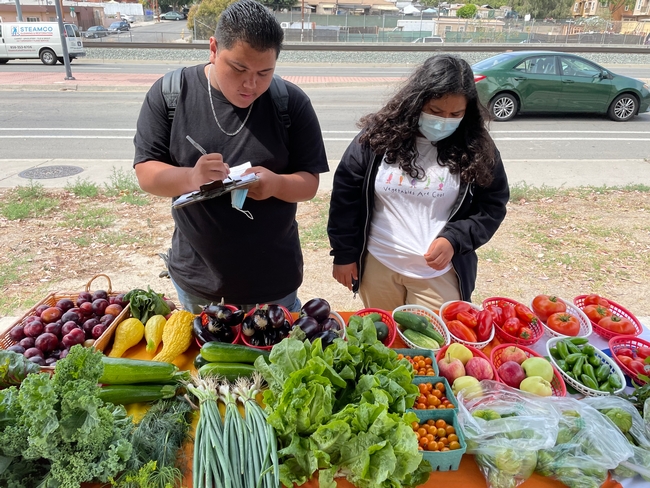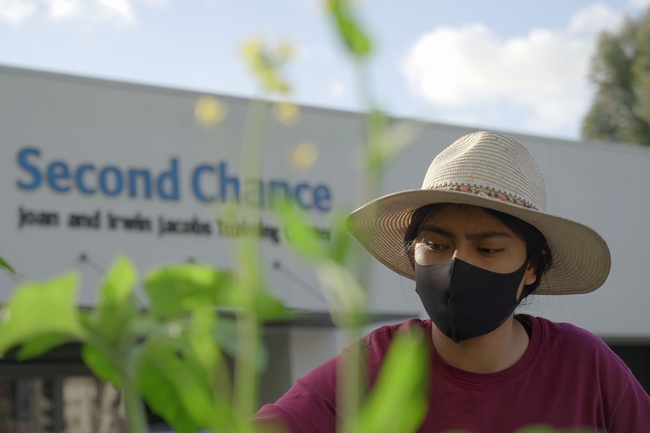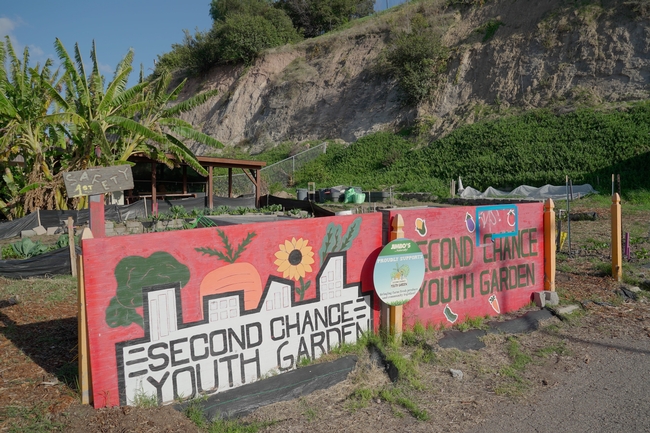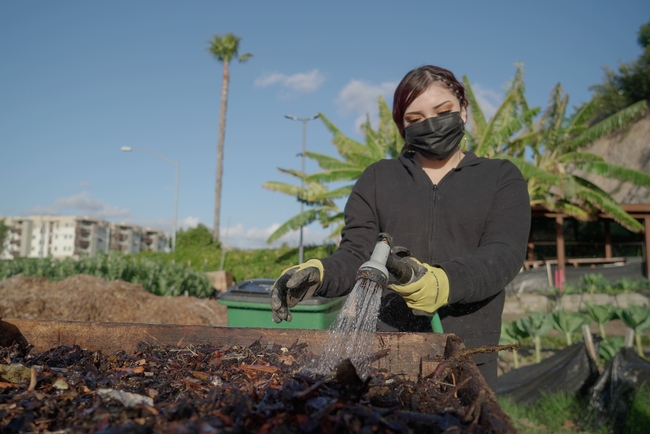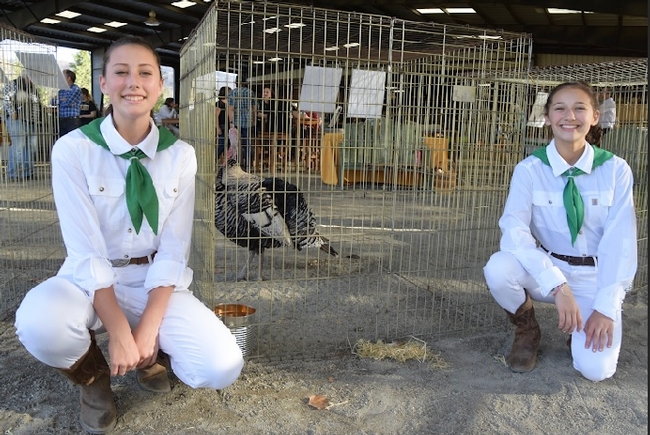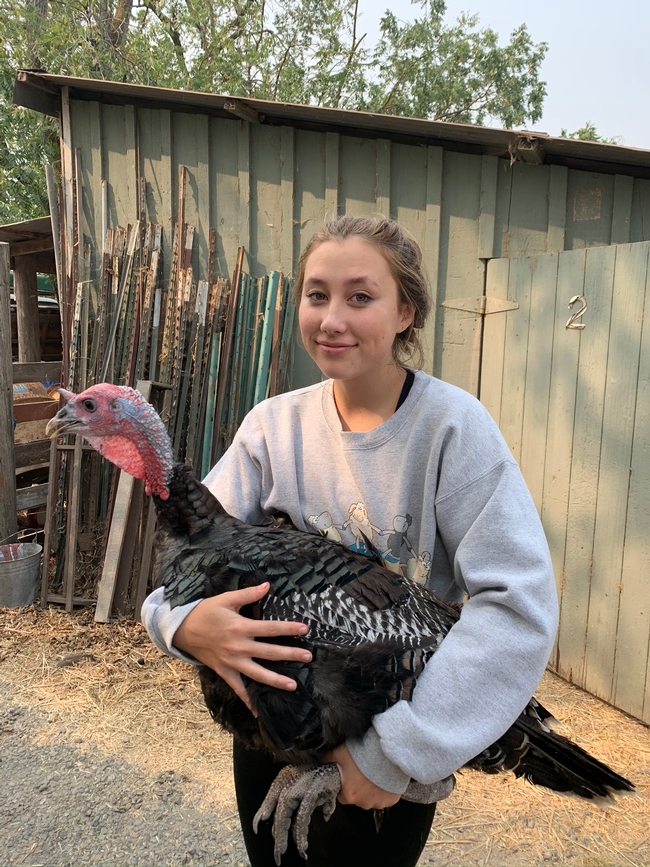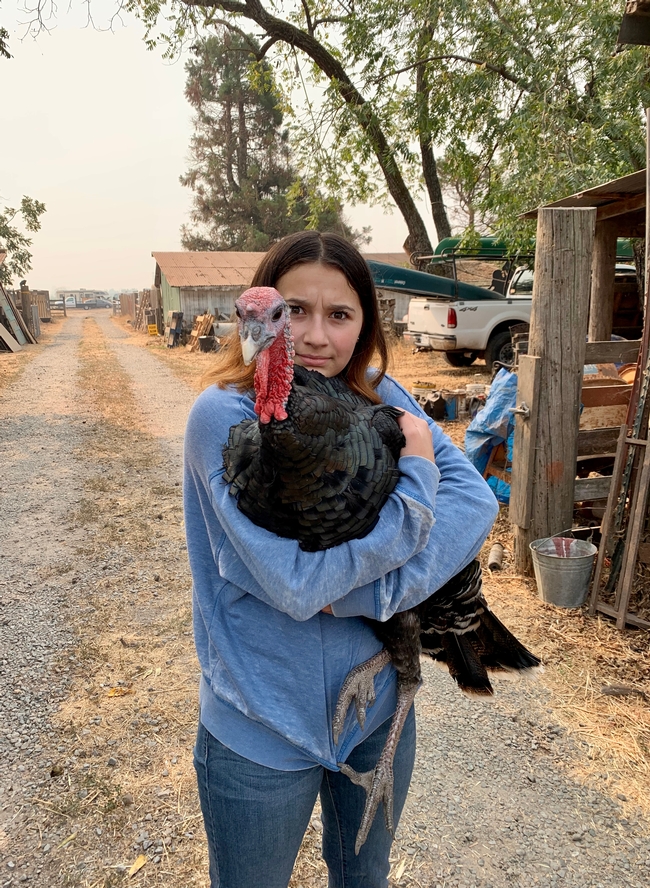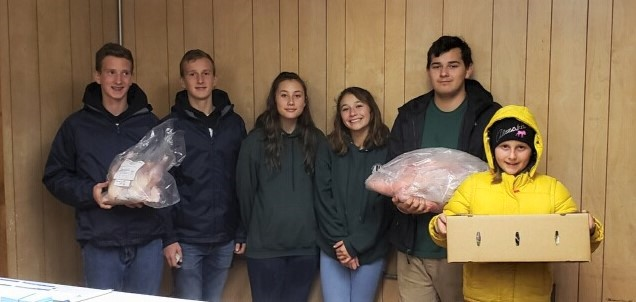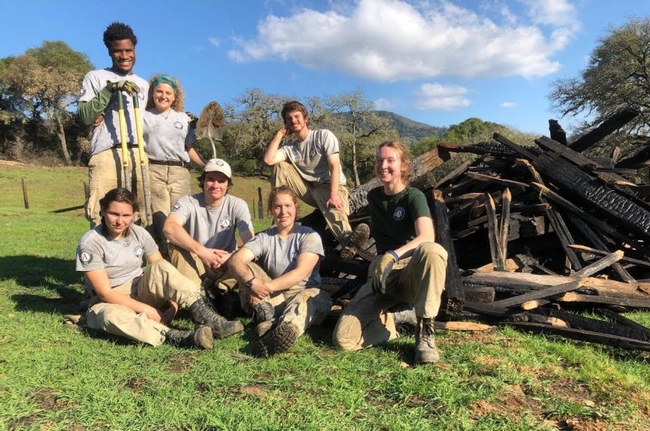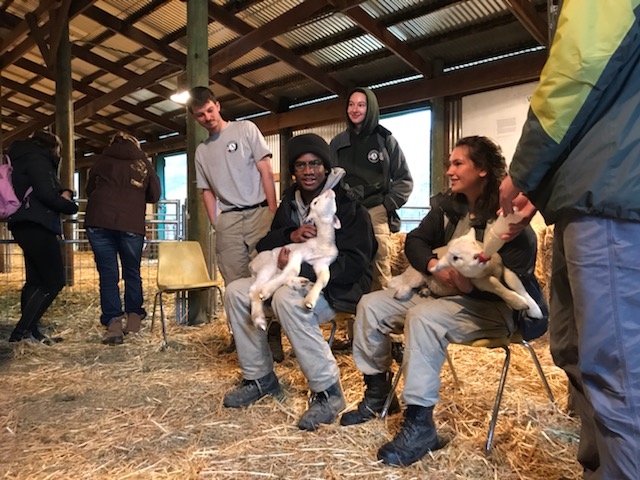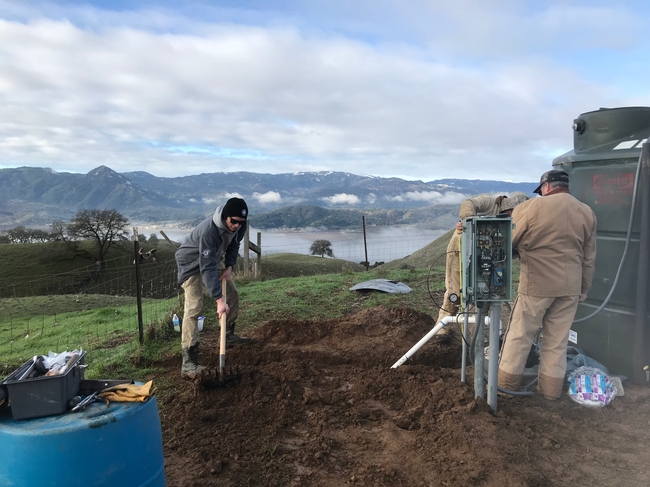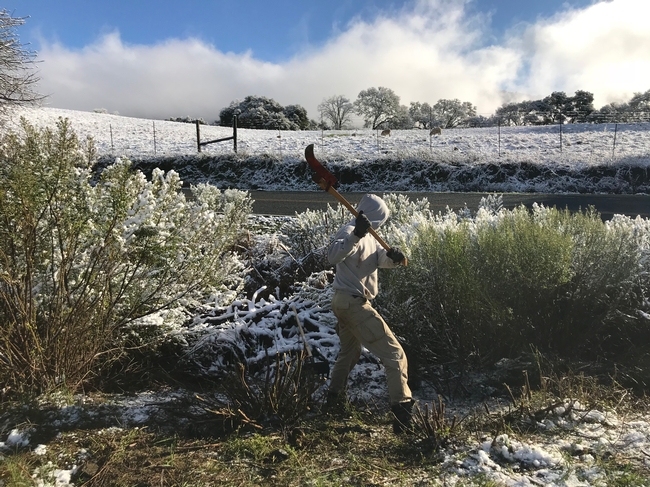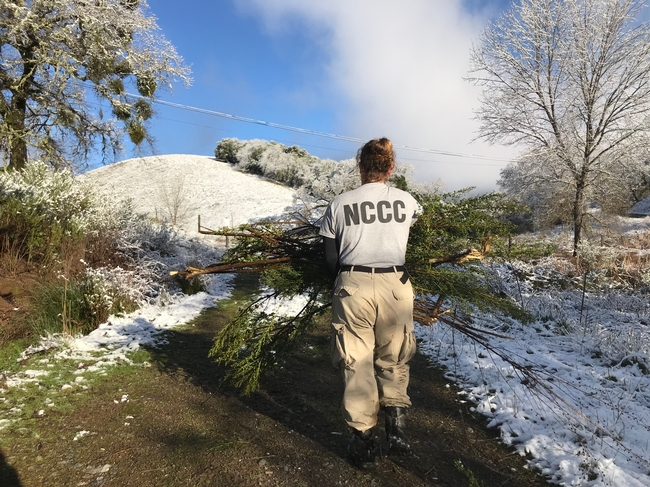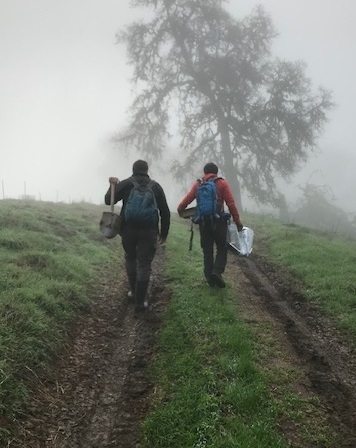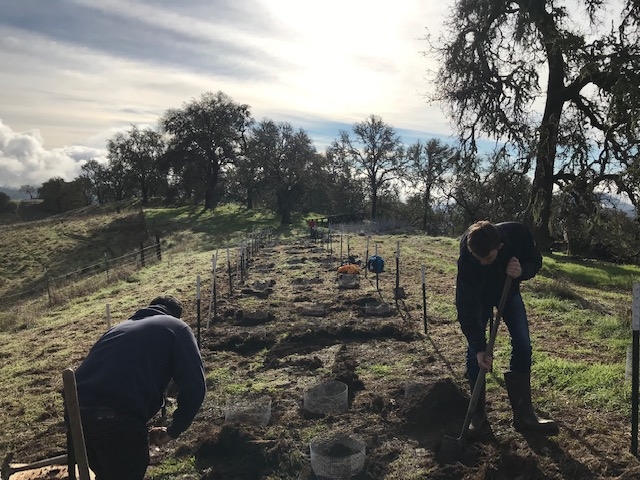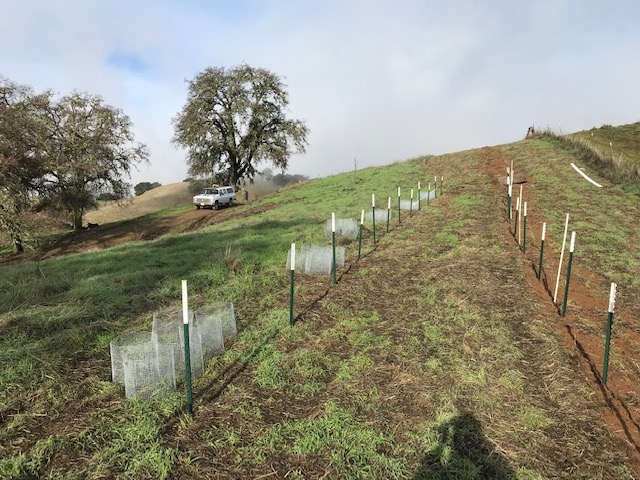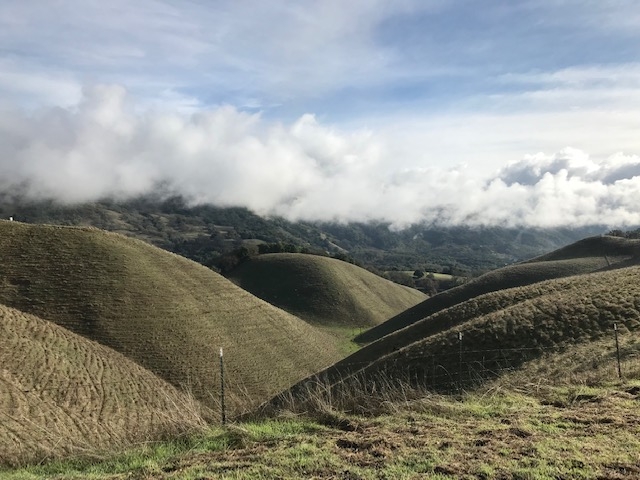
Posts Tagged: youth
Youth-run garden provides 10,000 pounds of produce for San Diego families
UC SAREP's Sustainable Agriculture and Food Systems grant helps support Second Chance garden
Fifteen-year-old Xavier knows the anger within him will never leave. “I can't ever get rid of it,” he said.
“I've always wanted to just fight for no reason; I just had an anger issue, losing my temper quick with people,” added Xavier, a ninth-grader in San Diego County. “I have high expectations of myself.”
Xavier is working to keep his emotions under control, and he has found a sense of calm through his volunteer work. He was an intern – and then a peer supervisor – in the youth-run garden of Second Chance, a San Diego-based organization that works to break the cycles of poverty and incarceration by providing housing and job training to adults and young people.
Operating their garden as a small farm business, youth in the program, ages 14 to 21, offer produce to the community through their farm stand and a CSA (Community Supported Agriculture) model.
“The project incorporates a ‘farm to fork' approach in which youth not only experience how to grow food, but how to cook and eat healthfully,” said Gail Feenstra, director of the University of California Sustainable Agriculture Research and Education Program, which has a grant program that funds research and education projects – such as the youth garden – supporting sustainable food systems.
“Second Chance works primarily with youth in communities of color, providing them with training and also helping them develop confidence in themselves,” Feenstra said.
Filling a critical need for fresh produce
Caelli Wright, program manager of the Second Chance youth garden, said that grant funds from SAREP – a program of UC Agriculture and Natural Resources – have been used to purchase the supplies needed to sustain the program. The garden has filled a critical need for produce during the COVID-19 pandemic.
“After the pandemic hit, we recognized the increased need for fresh food in our neighborhoods,” Wright said. “That need was already there – southeast San Diego is considered a ‘food swamp' or ‘food apartheid', if you will – and with the onset of COVID, that need just escalated with unemployment and complications in our food production systems.”
Through a partnership with UC San Diego Center for Community Health and Encanto Elementary School (located down the block from the garden), donations enabled the program to give its CSA shares to about 25 families at Encanto. Over the course of the pandemic, the youth have grown 10,000 pounds of produce to donate.
At the same time, the program helps the young participants grow. For Xavier, being outdoors with peers empowered him to develop positive relationships. Previously, as a student in a charter school program, he was not accustomed to interacting with people and groups. Volunteering in the youth garden has given him a fresh perspective and understanding of others.
“Learning to be patient with people and [to] accept sometimes that if I don't know something, I need to ask about it, because I used to be so in my ego that I thought I knew everything,” Xavier explained. “But I don't know everything – I just learned to accept some things…that's just being part of life. And that's something that the garden has helped me with, personally.”
Opportunities for personal, social growth
Developing – and redeveloping – social skills are especially important for students, as they return from the disconnections associated with remote learning.
“Right now, with a lot of students facing the aftermath of COVID and being restricted to learning at home and not getting as much social interaction in their daily lives, it's led to a lot of challenges, mental health-wise, and social and emotional learning-wise,” Wright said. “The garden program provides that opportunity that some youth have been missing out on.”
In southeast San Diego, such crucial opportunities for personal growth and career exploration are harder to come by, and Second Chance started the garden in 2012 to give youth a unique work experience and valuable skills. About 400 young people have participated in the program.
“The youth that we serve are coming from low-income neighborhoods that are underserved with resources,” Wright said. “They just are not exposed to the same opportunities [as those in higher-income areas] to build skills or be ready for the workforce or to reach higher education – so that's where our program comes in and helps deliver those needed services.”
Xavier, who originally came to the garden because he heard that landscaping could be a lucrative career, recently finished his second stint as a peer supervisor in the youth garden. With his new skills, he and his cousin are looking to start a business of their own, cutting grass and doing yardwork in their community.
And, late last month, Xavier transferred to a more traditional high school environment.
“Being in a charter school after two, three years,” he said, “I've realized I miss being around more people.”
4-H youths raise turkeys to save for college and learn about farming
While most Americans choose their Thanksgiving turkeys from the meat department at the local grocery store, Brylee Aubin and Yaxeli Saiz-Tapia can tell you the life histories of their holiday birds. The Sonoma County teenagers raise heritage turkeys together as part of a 4-H youth development project and sell them for Thanksgiving. For the last two years, Yaxeli's older brother Uli has joined the project and, between the three of them, they raised 47 turkeys this year.
The Heritage Turkey Project in Sonoma County has about 15 members of the UC Cooperative Extension's 4-H youth development program and the National FFA Organization growing more than 200 heritage turkeys this year, according to Catherine Thode, who has been leading the project for 15 years.
“Our project leaders are active breeders of heritage turkeys and some of our 4-H and FFA youth are now raising breeding pairs and hatching their own birds,” Thode said. “Each project member raises their small flock of birds on their own property and shoulders the responsibility of providing their feed and care.”
The Heritage Turkey Project promotes the preservation of heritage turkey breeds, sustainable farming and responsible animal husbandry. While raising the animals, the youths learn life skills and earn money for their work.
“The money I raise from raising and selling turkeys goes towards my college fund and to more 4-H projects like market goats or sheep,” said 15-year-old Brylee, who sells her turkeys for $9.50 per pound.
Three years ago, Brylee's neighbor, Yaxeli joined her in the heritage turkey project.
“I have learned how to care for animals, the importance of raising organic and the costs involved,” said Yaxeli, 14. “I have gained a firm understanding of how my birds are raised and processed versus corporate methods. Having the opportunity to participate in this project has strengthened my value for the importance of where my food comes from.”
Consumers benefit by getting turkeys that are farmed organically, fed high-quality grains, and never frozen, said Brylee.
“There are so many benefits to raising these beautiful birds,” said Uli Saiz-Tapia, 17. “First, you learn the cost of running a business, how to reinvest for the next year, the different stages of turkey growth and how to manage issues that arise such as the turkeys fighting, how they react to fluctuating temperatures, how to keep them safe and nourished properly. Learning about the process of getting our turkeys ready to be purchased has really benefitted my understanding of anatomy, the amount of work it takes in preparing them and the importance of not wasting food.”
The group sold out of turkeys in early November.
“Back in March, we really wondered if we should even do the project this year, not knowing what was going to happen with COVID restrictions and the impact on the economy,” Thode said. “We ended up with more project members than we've ever had, and over 200 turkeys to be sold for the Thanksgiving market.”
The 4-H members started the season with more turkeys, but lost some birds to predators. Wildfires seemed to drive more predators to the Sonoma County farms this year, she said.
“Things are fast and furious right now,” Thode said a week before Thanksgiving as the group prepared their turkeys for processing and distribution to people who placed orders. “I'm about to enter the busiest seven days of our year. It will take all weekend to have the birds processed, weighed, labeled. Then, we hunker down to sort and assign turkeys to our customer list.”
While selling turkeys, the group encourages customers to meet the farmers and to visit https://livestockconservancy.org/index.php/heritage/internal/conservation-priority-list#Turkeys to look up the history and breed characteristics of the turkey they are purchasing. In past years, some customers have taken photos of themselves with the person who raised their bird.
“We not only have a master list of customers and their desired sizes, but we create a spreadsheet for every project member with a list of the turkeys they've grown that year,” Thode said. “Each turkey is identified in the spring or early summer with a small metal wing band that lists the grower and an individual number for that turkey. When the turkey is sold, the buyer knows which project number grew their turkey, and the variety of turkey that they are purchasing. We think it's important that our customers know this. In fact, when they come to pick up their turkey, they write their check to the actual grower of their turkey.”
To learn more about the Heritage Turkey Project, visit https://heritageturkeyproject.webs.com.
Americorps NCCC Gold Seven Team Experience Hopland REC
The wonderful NCCC Gold Seven team have been working at HREC for the past 3 weeks, they have been so helpful - all the HREC staff will be so very sad to see them go! In this blog post we learn a little about the team members and get an overview of the work that they have been involved in, the interviews were conducted by Hannah Wood, the media lead for the team.
As the AmeriCorps NCCC team stationed at the UC ANR Hopland Research and Extension Center, we've had plenty of projects to keep us busy! In the three weeks we've been volunteering here, we've helped repair fence lines previously burnt in the River Fire, were put in charge of some daily barn chores, helped build infrastructure for upcoming research projects, assisted with K-12 educational programs, cleared brush, helped tidy up the place, and sometimes worked closely with the sheep (tagging, paint branding, raising bummer lambs, and giving vaccines).
Although the work was daunting at times, and the weather was never perfect, we were thankful to be working and living on this beautiful property right alongside the welcoming staff and their families. We learned loads of information about California seasons and climates, lambing, the important research projects going on, Northern California ecosystems, wildlife in the area, and wildfire mitigation and recovery. And the baby lambs made our days brighter… even with rainy skies!
I've asked a few of my fellow Corps members some questions about their personal experiences at the UC ANR Hopland Research and Extension Center… and here's what they said!
Q: What was your favorite part of volunteering at HREC?
I enjoyed learning a ton from the very knowledgeable HREC staff. Their welcoming attitude enabled us to get a firsthand experience of what living and working at a research extension center entails. We worked with each and every person on staff and they all showed us the details and unique experiences of their work duties, while also being very open and friendly toward us.
-Jared Gasper: 19 yrs old, from Nebraska
Q: What has made your experience at HREC?
I liked getting insight into the life of a shepherd and seeing the day to day responsibilities of working on a ranch. I also really enjoyed learning about all the research projects! Overall my time here has been extremely educational and useful for developing myself and my interests, specifically when working with the Forest Advisor for Mendocino Lake and Sonoma counties on post fire vegetation plot surveys.
-Dariel Echanis: 18 yrs old, from Vermont
Q: What's it like living at the HREC?
I think we all can say it's been extremely comfortable living and working on the HREC campus. We were very cozy in the dorm house, and enjoyed going for hikes and doing physical training on our off time.. which included beautiful views of course! Hannah Bird made us feel right at home with her caring and immediate attention, giving us fresh lamb meat, welcoming us into her home for dinner, and making sure we were always having new and exciting experiences:)
-Hannah Wood: 22 yrs old, from New York State
Q: What was it like as the Team Leader coordinating daily projects with the staff?
The staff at HREC are all incredibly helpful and organized so I had a really great experience working with them. I never had trouble getting into contact with anyone and every member of the staff was happy to answer questions. The team got to work with a number of staff members who all had diverse bodies of knowledge and we learned a lot from them! Working at HREC has been a wonderful experience for me and for the team.
-Jessi Hagelshaw: 22 yrs old, from California
Q: What was it like volunteering on the weekends with the Ukiah Animal Shelter?
It was really rewarding! It was good to see that none of the animals we worked with before Christmas break were still there when we returned in January. I'm glad we got a chance to help out and I would love to do more work with animal shelters in the places we'll work at in the future.
-Alex Faeth: 22 yrs old, from New Jersey
Q: How was it working with the K-12th graders that came to HREC to learn about sheep?
Working with the school children was a great experience. The weather was cold and wet a lot of the days we did field trips but the teachers and students were enthusiastic to hike the property, which in turn, energized the staff and volunteers!
-Danny Zoborowski: 24 yrs old, from New York State
Q: Anything you'd like to say to the HREC and Hopland/Ukiah communities?
HREC's hospitality was great. The entire staff was welcoming and helpful, the dorms are nice and cozy, the land is beautiful, and it is a great place to hike... or just roam. Thank you HREC staff!
-Amir Corbett: 20 yrs old, from Pennsylvania
Amir and Alex show the "bummer" or adopted lambs to the K-12 students.
Hard work on the hill!
All the Americorps Gold Seven team worked so hard rain, snow or shine!
Clearing brush, to be prepared for future fire was one of the key tasks that the team helped HREC with.
HREC Youth Volunteers Support Oak Research
My name is Valentina Evans, and I am a new volunteer at the UC Hopland Research and Extension Center. My partners Benjamin Evans, and Zane Petersen have chosen to volunteer with me at the HREC for our senior project at Ukiah High School. A few weeks ago on the twenty-first of December we volunteered to help two researchers, Paulo who studied at UC Santa Cruz, and Wyath, who is still studying at Humboldt State University, to plant acorns from different ecosystems, and analyze how they will adapt to conditions with more water, less water, more sunlight or a lack of sunlight. This study is part of Dr. Blair McLaughin's study from the Zavaleta Lab at UC Santa Cruz.
We started off by digging holes about 1 foot deep and laying a thin square piece of chicken wire at the bottom of the holes to prevent gophers from entering and eating the acorns. We then took a circular strip of chicken wire and placed it on top of the flattened piece at the bottom. With the second strip of chicken wire standing horizontal, we continued by covering the holes with the same dirt we originally dug out. Now with the metal secured in place, Paulo came around and gently placed the acorns inside of the holes. The hands-on experience was extremely fascinating, not to mention peaceful. The view at the top of the hill was breathtaking, and the weather was just perfect. The entire process was tiring, but having had the opportunity to participate in a lab/research project made the whole experience worth it.
Although the project will not produce any data until the acorns sprout, the idea behind the project is captivating. Paulo and Wyath are studying the growth of oak trees from all sorts of climates, locations, and ecosystems. Some of the acorns are from northern California and others from way down in southern California. They will be monitoring the water levels, and amount of sunlight the oak trees will receive, all in hopes to see how the oak trees will adapt to different changes in their environments. Seeing as how I want to major in Biological Sciences in college, this experience was exceptionally informative for me and has taught me how critical patience, effort and time are in order to successfully accomplish a lab and receive the most accurate facts. I am very grateful to have been able to participate in this ongoing project and am looking forward to continuing to be a part of the younger generation who can benefit from having the Hopland Research and Extension Center available to us, to further our knowledge about the environment.
Kids and Bugs Go Well Together: Check Out the Dixon May Fair
Kids and bugs go well together. Take the entries in Today's Youth Building at the 143rd annual Dixon May Fair, which opened Thursday, May 10 and continues through Sunday, May 13. Some of the exhibitors focused on honey bees, butterflies, dragonflies, and bumble bees--and some ventured out of the...
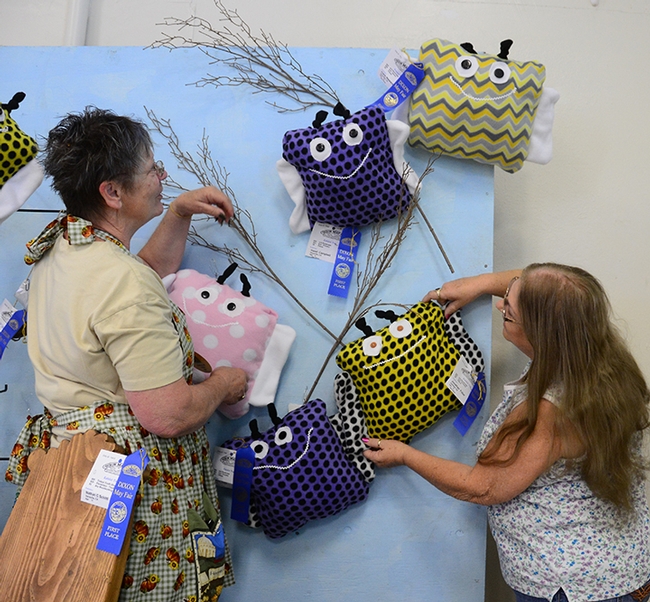
Dixon May Fair Youth Building superintendent Building superintendent Stephanie Hill (left) of Yuba City and assistant building superintendent Pat Connelly of Vacaville hang bumble bee pillow, the work of Solano County 4-H'ers. (Photo by Kathy Keatley Garvey)
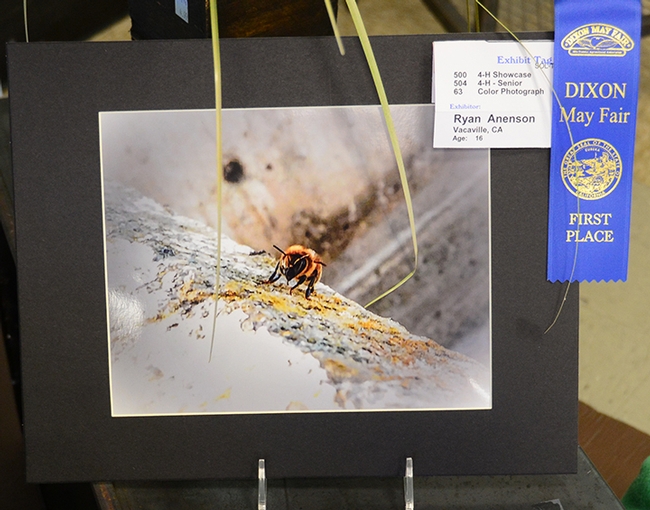
Beekeeper Ryan Anenson, 16, of the Tremont 4-H Club, Dixon, took this blue-ribbon winner, close-up of a bee. Overlapping the photo are plant leaves. (Photo by Kathy Keatley Garvey)
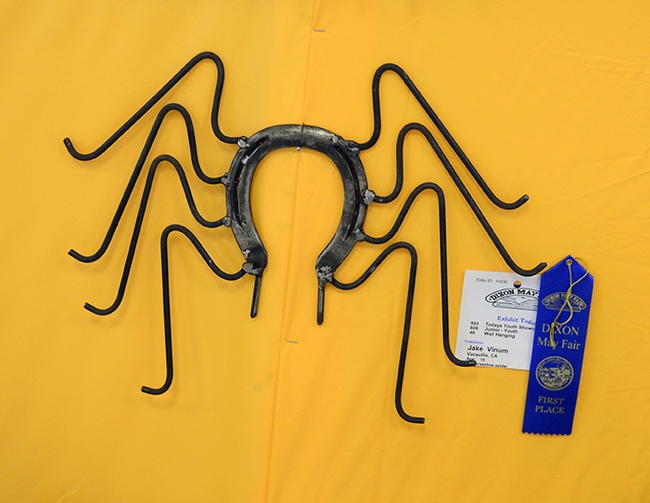
Jake Vinum, 15, of Vacaville, won a blue ribbon for his wall hanging, titled "Horseshoe Spider," cleverly crafted with a horseshoe and "spider legs." (Photo by Kathy Keatley Garvey)
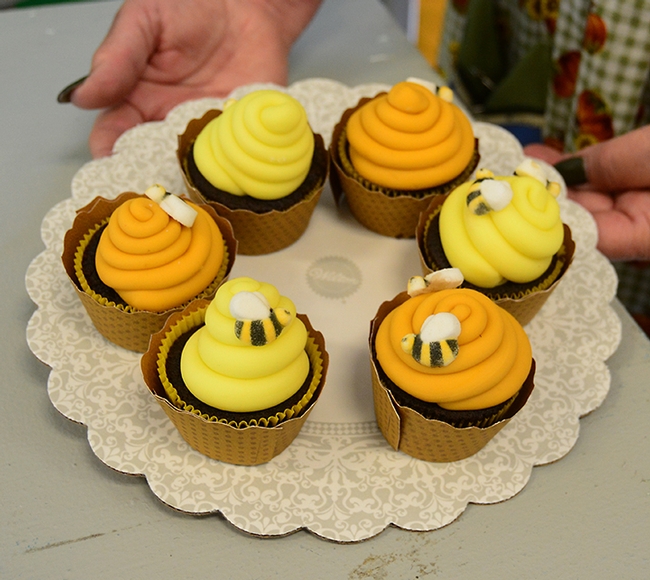
Khole Cahoon, 13, of Vacaville won a blue ribbon for her chocolate ganache cupcakes, decorated with bees. (Photo by Kathy Keatley Garvey)
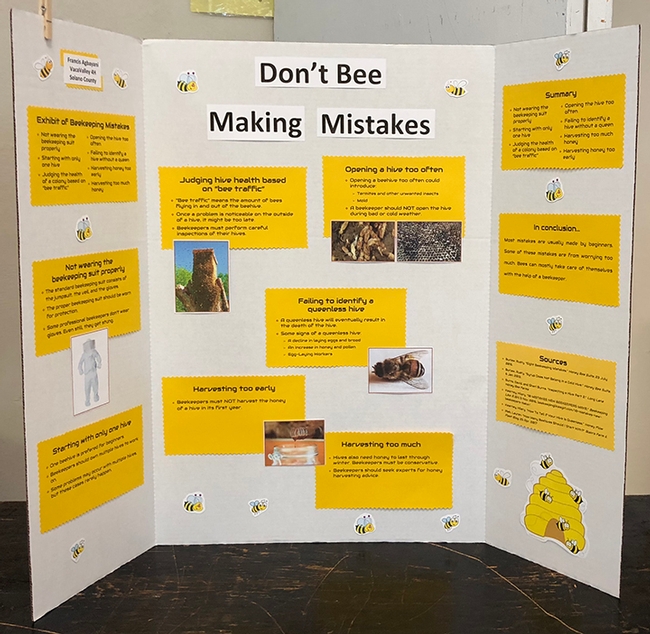
Beekeeper Francis Agbayani, 12, of the Vaca Valley 4-H Club, Vacavile, is displaying his 4-H project, "Don't Bee Making Mistakes," a blue-ribbon winner. (Photo by Kathy Keatley Garvey)

